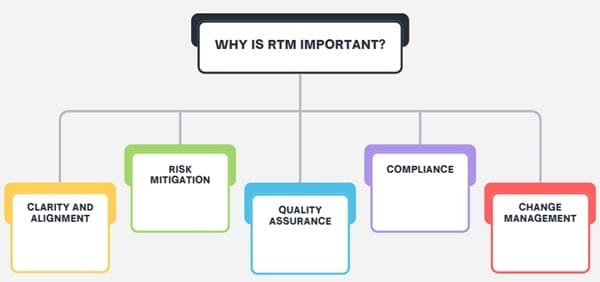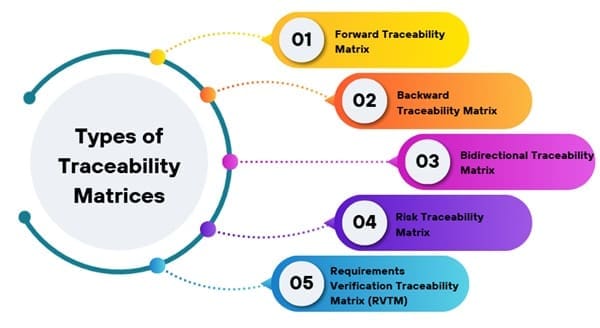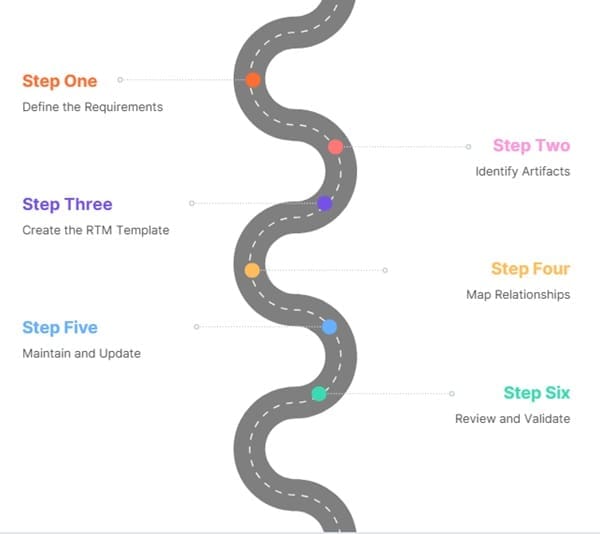A requirements traceability matrix (RTM) serves as the backbone of successful project management and software development. Simply put, it’s a comprehensive document that links requirements throughout the validation process, ensuring every business need connects to corresponding test cases, design elements, and deliverables.
Think of an RTM as a roadmap that guides your project from initial requirements gathering to final delivery. This powerful tool creates transparency, accountability, and comprehensive coverage across all project phases. Moreover, it acts as a safety net, preventing critical requirements from falling through the cracks during development.
Table of contents
What is a Requirements Traceability Matrix?
A Requirements Traceability Matrix (RTM) is a document that links requirements throughout the project lifecycle, ensuring that each requirement is tracked from inception to delivery. Think of it as a roadmap that connects the dots between what the client wants, what the team builds, and what gets tested. By mapping requirements to design, development, and testing phases, the RTM ensures nothing slips through the cracks.
The RTM acts as a single source of truth, providing forward traceability (from requirements to deliverables) and backward traceability (from deliverables back to requirements). This bidirectional traceability ensures that every feature or function aligns with the original project goals. Whether you’re working in Agile, Waterfall, or hybrid methodologies, the RTM is your anchor for accountability.
Why is RTM Important?
Imagine building a house without a blueprint. You might end up with a kitchen where the bathroom should be. Similarly, in software development or project management, the RTM ensures every requirement is addressed, reducing risks like scope creep, missed deliverables, or costly rework. Here’s why it matters:

- Clarity and Alignment: The RTM aligns stakeholders, developers, and testers on project objectives.
- Risk Mitigation: By tracking requirements, it minimizes the chance of overlooking critical features.
- Quality Assurance: It ensures every requirement is tested, improving product quality.
- Compliance: For industries like healthcare or aerospace, RTMs are critical for regulatory compliance.
- Change Management: It helps track changes to requirements, ensuring updates are reflected across the project.
Public, Onsite, Virtual, and Online Six Sigma Certification Training!
- We are accredited by the IASSC.
- Live Public Training at 52 Sites.
- Live Virtual Training.
- Onsite Training (at your organization).
- Interactive Online (self-paced) training,
Types of Traceability in Project Management
Forward traceability tracks requirements from their origin through design, implementation, and testing phases. This approach ensures every requirement receives proper attention during development.
Conversely, backward traceability works in reverse, linking test cases and deliverables back to original requirements. This method verifies that all implemented features serve specific business purposes.
Bidirectional traceability combines both approaches, creating comprehensive coverage that tracks relationships in both directions. This robust method provides complete visibility into requirement lifecycles.
Also Read: Pugh Matrix
Types of Traceability Matrices

Not all RTMs are created equal. Depending on the project’s complexity and goals, you might use different types of traceability matrices:
- Forward Traceability Matrix: Maps requirements to design and development artifacts, ensuring each requirement is implemented.
- Backward Traceability Matrix: Links deliverables back to their originating requirements, verifying that nothing extraneous was built.
- Bidirectional Traceability Matrix: Combines forward and backward traceability for comprehensive tracking.
- Risk Traceability Matrix: Focuses on linking risks to mitigation strategies, often used in high-stakes projects.
- Requirements Verification Traceability Matrix (RVTM): Emphasizes verification, ensuring each requirement is tested and validated.
Each type serves a unique purpose, but the bidirectional matrix is the most common, offering a holistic view of the project.
How to Create a Requirements Traceability Matrix?

Here’s a step-by-step guide to how to create a traceability matrix in Excel or any other tool:
Step 1: Define the Requirements
Start by gathering all project requirements. These could come from stakeholders, user stories, or project charters. Assign each requirement a unique ID for easy tracking. For example:
- REQ-001: The system shall allow users to log in with a username and password.
- REQ-002: The system shall generate a monthly sales report.
Step 2: Identify Artifacts
List the artifacts that will be traced to the requirements. These might include:
- Design documents
- Test cases
- Code modules
- User manuals
Step 3: Create the RTM Template
A requirements traceability matrix template typically includes columns like:
- Requirement ID
- Requirement Description
- Source (e.g., stakeholder or document)
- Design Artifact
- Test Case ID
- Status (e.g., In Progress, Completed, Tested)
Here’s a simple requirements matrix template in Excel:
| Requirement ID | Description | Source | Design Artifact | Test Case ID | Status |
| REQ-001 | User login functionality | Stakeholder A | Design-001 | TC-001 | Tested |
| REQ-002 | Monthly sales report generation | Stakeholder B | Design-002 | TC-002 | In Progress |
Step 4: Map Relationships
Link each requirement to its corresponding design, development, and test artifacts. This creates a clear chain of accountability. For example, REQ-001 might link to a login module in the codebase and a test case that verifies successful login.
Step 5: Maintain and Update
An RTM is a living document. As requirements change, update the matrix to reflect new additions, modifications, or deletions. Tools like Jama Requirements Traceability or RTM software can automate this process, making it easier to manage large projects.
Step 6: Review and Validate
Regularly review the RTM with stakeholders to ensure accuracy. Validate that all requirements are addressed and tested before project closure.
Traceability Matrix in Software Testing
In software testing, the RTM is a game-changer. It ensures that every requirement has a corresponding test case, reducing the risk of untested features. For example, in a traceability matrix in software testing, you might map REQ-001 (user login) to Test Case TC-001, which verifies that users can log in with valid credentials.
The RTM also helps testers prioritize their efforts. By focusing on high-priority requirements, teams can optimize testing cycles and deliver higher-quality software. In Agile environments, the traceability matrix in Agile adapts to iterative development, ensuring that each sprint delivers traceable, testable features.
Tools for Requirements Traceability
While Excel is a popular choice for creating an RTM, specialized requirements traceability tools can streamline the process. Some popular options include:
- Jama Connect: Offers robust traceability features for complex projects.
- IBM Rational DOORS: Ideal for industries with strict compliance requirements.
- Helix ALM: Combines requirements management with test case tracking.
- ReqView: A lightweight tool for small to medium-sized projects.
These tools support live requirements traceability, providing real-time updates as requirements evolve. For teams on a budget, a requirements traceability matrix template in Excel or Google Sheets is a cost-effective alternative.
Also Read: Eisenhower Matrix
Example
Let’s look at a requirements traceability matrix example for a mobile banking app:
| Requirement ID | Description | Source | Design Artifact | Test Case ID | Status |
| REQ-001 | Secure user authentication | Stakeholder A | Login Module | TC-001 | Tested |
| REQ-002 | Transfer funds between accounts | Stakeholder B | Transfer Module | TC-002 | In Progress |
| REQ-003 | Display transaction history | Stakeholder C | History Module | TC-003 | Not Started |
This matrix ensures that each feature (e.g., fund transfer) is designed, coded, and tested, with clear links to the original requirement.
Challenges of Using an RTM
While the RTM is a powerful tool, it’s not without challenges:
- Time-Intensive: Creating and maintaining an RTM can be labor-intensive, especially for large projects.
- Complexity: Mapping relationships across hundreds of requirements requires meticulous attention to detail.
- Change Management: Frequent requirement changes can make the RTM outdated if not updated regularly.
To overcome these challenges, use requirement traceability matrix tools and involve the entire team in maintaining the matrix.
RTM in Project Management
In project management, the requirements traceability matrix in project management bridges the gap between planning and execution. For PMP-certified professionals, the RTM aligns with the Project Management Body of Knowledge (PMBOK) principles, ensuring requirements are traceable to project deliverables. It also supports risk management by linking requirements to potential risks, creating a risk traceability matrix.
For example, a project manager might use an RTM to ensure that a new software feature complies with regulatory standards, tracing each requirement to its validation test.
Best Practices for an Effective RTM
To maximize the value of your RTM, follow these best practices:
- Keep It Simple: Avoid overcomplicating the matrix with unnecessary details.
- Use Unique IDs: Assign clear, unique identifiers to requirements and artifacts.
- Automate Where Possible: Leverage RTM software to reduce manual effort.
- Collaborate: Involve stakeholders, developers, and testers in the RTM process.
- Update Regularly: Treat the RTM as a living document, updating it as the project evolves.
FAQs on RTM
What is an RTM in project management?
An RTM, or Requirements Traceability Matrix, is a tool used in project management to track requirements from inception to delivery, ensuring alignment with project goals.
How do I create a traceability matrix in Excel?
To create a traceability matrix in Excel, list requirements with unique IDs, map them to design and test artifacts, and update the matrix as the project progresses.
What is bidirectional traceability?
Bidirectional traceability involves tracking requirements forward to deliverables and backward to their origins, ensuring completeness and alignment.
Why is a traceability matrix important in software testing?
In software testing, a traceability matrix ensures every requirement has a corresponding test case, reducing the risk of untested features and improving quality.
What tools can I use for requirements traceability?
Popular tools include Jama Connect, IBM Rational DOORS, Helix ALM, and ReqView. Excel is also a cost-effective option for smaller projects.
Final Words
The Requirements Traceability Matrix is more than just a document—it’s a lifeline for successful project delivery. By linking requirements to design, development, and testing, the RTM ensures clarity, reduces risks, and enhances quality. Whether you’re managing a complex software project or a simple product launch, the RTM is your key to staying on track.

About Six Sigma Development Solutions, Inc.
Six Sigma Development Solutions, Inc. offers onsite, public, and virtual Lean Six Sigma certification training. We are an Accredited Training Organization by the IASSC (International Association of Six Sigma Certification). We offer Lean Six Sigma Green Belt, Black Belt, and Yellow Belt, as well as LEAN certifications.
Book a Call and Let us know how we can help meet your training needs.




















